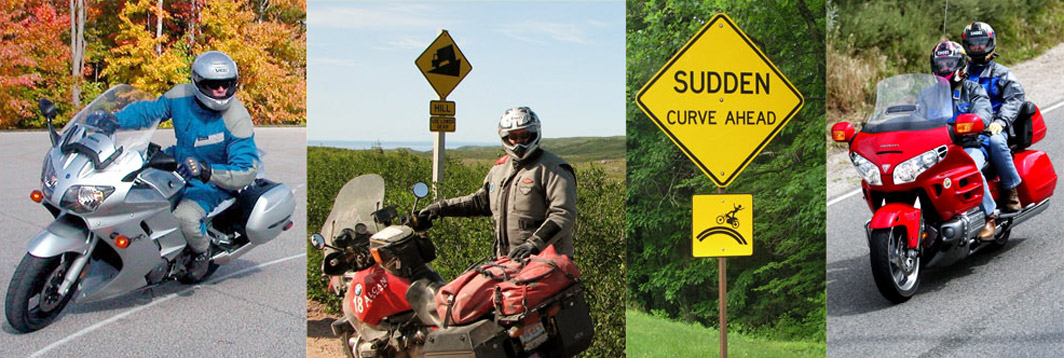Full Protective Outer Gear
This section provides research on protective gear other than helmets. Reducing injury when crashes do occur means riders must wear protective equipment. This comes in two forms – helmets to protect the head, face and brain and motorcycle jackets, pants, gloves and boots to protect the remainder of the riders body. For research on the protective benefits of helmets see Research – Helmets. While the research regarding the protective benefits of full motorcyclist gear (padded tear‐resistant clothing, gloves, and boots) is limited, the available information clearly demonstrates protective gear works to reduce injury in the event of a crash. Protective clothing is unlikely to prevent serious injury in high impact crashes, but protective gear can reduce gravel rash, friction and exhaust pipe burns, stripping of skin and muscles, torn or severed ligaments, some broken bones and the infection of wounds. Proper gear can also enhance comfort and make riders more visible to other motorists.
The major work in research on motorcyclist protective clothing has been conducted by Liz de Rome, Injury Division, The George Institute for Global Health, Australia.
An excellent resource for choosing protective gear is the website of MotoCap. A description of the information found on the MotoCap site is here.
Protective Gear Research Studies
2016 – “The Efficacy of a Motocross Neck Brace in Reducing Injury”
Neck and upper spine fracture account for approximately 10% of all injuries to motocross riders in a crash [Colburn, 2003]. To mitigate such injuries, neck braces have been designed and marketed as a countermeasure for neck injury during an impact. The objective of this study was to investigate the efficacy of a motocross neck brace in reducing cervical spine injury following helmeted head impact.
2014 – “Use of Back Protector Device on Motorcycles and Mopeds in Italy”
This study points out that greater use of BPD could reduce the number of injuries to the spinal column resulting from road traffic accidents involving motorized two-wheeled vehicles. Concerning level of protection, there are no differences between drivers and passengers. In most severely injured motorcyclists (i.e., hospitalized or deceased), the percentage of injuries to the spine was lower (13.6%) among those who used a high-level safety device (hard-shell BPD and/or airbags) and rose to 27.3% among those who used only protective clothing (P¼0.022). When the variables potentially affecting the results of not using a high-safety device were controlled, analysis showed that the odds of serious spinal injury were 2.72 to 2.81 times greater.
2013 – “Roles of Motorcycle Type and Protective Clothing in Motorcycle Crash Injuries”
The aims of this study were to identify subgroups of motorcyclists with a higher accident risk and evaluate the efficiency of protective clothing for preventing injuries.
2012 – “Effectiveness of Motorcycle Protective Clothing: Riders’ Health Outcomes in the Six Months Following a Crash”
Abstract. Apart from helmets, little is known about the effectiveness of motorcycle protective clothing in reducing injuries in crashes. The study aimed to quantify the association between usage of motorcycle clothing and injury in crashes.
2011 – “The GEAR Study by the George Institute for Global Health”
Overview and methods of research which examined the association between the use of protective clothing in motorcycle crashes and the severity and long-term consequences of any injuries sustained.
2011 – “Motorcycle Protective Clothing: Protection from Injury or Just the Weather?”
Detail of the study examining the effectiveness of specialized motorcycle protective clothing, particularly fitted body armor.
2010 – “Design and Numerical Evaluation of an Airbag Jacket for Motorcyclists
The need of passive safety devices, able to reduce the accidents and the severity of injuries suffered by motorcyclists, distinctly arises from data on accident statistics. In this paper, the effectiveness of an airbag device fitted in the biker's garments has been verified through various numerical simulations.
2008 – “Development and Evaluation of a New Rider Airbag Safety System for Thorax Protection”
This paper focuses on the use of the numerical simulation to predict rib fractures in case of motorcyclist accident and to evaluate a new safety system: an airbag integrated in a jacket. Different simulations, with and without airbag were performed to evaluate the influence of various parameters. The study showed that the airbag system increases the security of the motorcyclist.
2006 – “The Injury Reduction Benefits of Motorcycle Protective Clothing”
A presentation at the National Transportation Safety Board (NTSB) Motorcycle Safety Forum which provides a background and overview.
2003 – “Motorcycle Protective Clothing”
A presentation by leading researchers which describes a comprehensive review of research into the safety value of motorcycle protective clothing.

